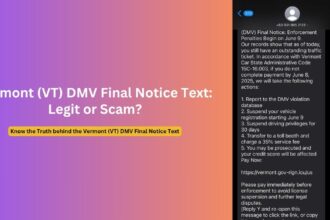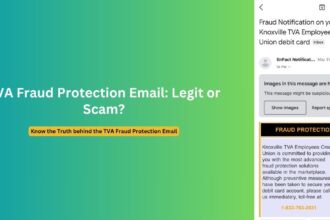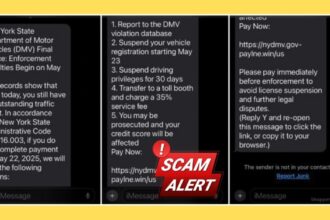Massachusetts pair arrested after months-long scheme targeting Long Island woman
A sophisticated bank fraud operation that drained nearly $400,000 from a 61-year-old Long Island woman’s accounts came to a dramatic end when police arrested two Massachusetts residents following a high-speed chase and crash in Greenvale. The arrests have shed light on an increasingly common scam where criminals impersonate bank representatives to exploit victims’ trust and financial security.
The Arrests: Chase, Crash, and Capture
Dominique Jones, 24, and Jean Saint Fort, 22, both from Chelsea, Massachusetts, were arrested on May 2, 2025, following an undercover operation by Port Washington and Nassau County Police. The investigation culminated in front of 90 Northern Boulevard in Greenvale, where the suspects were finally apprehended.
According to police reports, Jones attempted to flee the scene in a 2018 Jeep Compass, crashing into both a Port Washington Police vehicle and an unoccupied SUV. Despite Jones’ resistance, officers were able to subdue and arrest her. Saint Fort, who was a passenger in the vehicle, was arrested without incident.
A search of their vehicle revealed a loaded 9mm handgun and multiple stolen credit cards in Jones’ possession, adding weapons and identity theft charges to their fraud accusations.
The pair was arraigned on May 8, 2025, at First District Court in Hempstead, facing multiple felony charges.
Inside the $387,000 Scam Operation
The scheme began on February 27, 2025, when the victim received an unsolicited call from a person claiming to be a representative of Chase Bank’s fraud department. The caller informed the victim about purported “suspicious transactions” on her account—a common tactic used to create panic and urgency.
Over the next two months, the scammers methodically built trust with the victim, using sophisticated social engineering techniques to convince her to make multiple large withdrawals from her account. By the time the scheme was discovered in late April, the victim had handed over a staggering $387,000 to the scammers.
What makes this case particularly notable is the duration and scale of the fraud. Unlike many scams that aim for quick payouts, Jones and Saint Fort allegedly maintained the ruse for two months, gradually extracting larger sums from the victim as trust was established.
How Bank Impersonation Scams Work
This case highlights the meticulous methodology behind sophisticated bank impersonation scams. Understanding how these operations function can help individuals protect themselves and vulnerable family members.
Phase 1: Initial Contact and Trust Building
The scam typically begins with a phone call from someone claiming to represent a legitimate bank’s fraud department. These calls often display spoofed phone numbers that appear to match the bank’s official contact information. The caller creates urgency by alerting the victim to supposed “suspicious activity” on their account.
Phase 2: Information Gathering
Once the victim is concerned about their account security, the scammer begins gathering personal information under the guise of “verifying” the account. This may include:
- Account numbers
- Social Security numbers
- Online banking credentials
- Personal identifying information
Phase 3: Manufactured Emergency
After establishing credibility, the scammer creates a false narrative about immediate threats to the victim’s funds. Common stories include:
- Claims of unauthorized international transfers
- Allegations of employee theft within the bank
- Warnings about imminent large withdrawals
- Supposed investigations into fraud requiring “temporary” transfers
Phase 4: Fund Extraction
The final phase involves convincing victims to withdraw their own money and transfer it to “secure accounts” or hand it over to “investigators” who are actually part of the scam operation. Victims are often sworn to secrecy about these transactions, being told that discussing them could “compromise the investigation.”
Criminal Allegations and Scam Charges Against Dominique Jones & Saint Fort
The case against Jones and Saint Fort includes multiple serious charges that could result in lengthy prison sentences if they are convicted.
Jones faces the more extensive list of charges, including:
- Attempted grand larceny
- Two counts of second-degree criminal possession of a weapon
- Two counts of fourth-degree criminal possession of stolen property
- Resisting arrest
- Criminal mischief
Saint Fort has been charged with:
- Attempted grand larceny
- Two counts of criminal possession of a weapon
Legal experts familiar with similar cases suggest that the presence of firearms and stolen credit cards significantly elevates the seriousness of the charges, potentially leading to consecutive sentences if the defendants are found guilty on all counts.
The “attempted” grand larceny charges suggest that the police may have intercepted the suspects before they could collect an additional planned payment from the victim, indicating that the undercover operation may have prevented even greater financial losses.
Red Flags: Identifying Bank Impersonation Scams
Financial security experts point to several warning signs that can help consumers identify potential scams before becoming victims:
Unsolicited Contact
Legitimate banks rarely initiate contact regarding security issues via phone. Instead, they typically flag suspicious transactions automatically and wait for customers to verify them through official bank applications or by calling the bank directly.
Pressure Tactics
Scammers rely heavily on creating a sense of urgency to prevent victims from thinking clearly or consulting with others. Any representative pressuring for immediate action should be viewed with extreme suspicion.
Unusual Payment Methods
Legitimate banks will never ask customers to:
- Withdraw large sums of cash
- Purchase gift cards or cryptocurrency
- Wire money to “secure” accounts
- Provide funds to couriers or representatives in person
Secrecy Requirements
Requests to keep transactions secret, even from family members or other bank employees, are major red flags. Fraudsters use isolation tactics to prevent victims from receiving outside advice that might expose the scam.
Caller ID Spoofing
Modern technology allows scammers to fake the phone numbers that appear on caller ID systems. Just because a call appears to come from your bank doesn’t mean it’s legitimate.
Protecting Yourself from Bank Fraud Scams
Security experts and law enforcement officials recommend several preventative measures to protect yourself from similar scams:
Never Act on Inbound Calls
When receiving calls about financial matters, hang up and call your bank directly using the number on the back of your card or from the official website. This simple step defeats caller ID spoofing.
Implement Banking Alerts
Set up automatic notifications for transactions above a certain threshold. This ensures you’re immediately aware of any unusual activity on your accounts.
Establish a “No Phone Banking” Policy
Inform elderly family members that legitimate banks will never:
- Call to request personal information
- Ask for funds to be withdrawn or transferred by phone
- Send representatives to collect cash or cards
Use Multi-Factor Authentication
Enable all security features offered by your financial institutions, including verification codes, biometric authentication, and transaction passwords.
Regular Account Monitoring
Check account balances and transactions at least weekly to identify any unauthorized activity quickly.
Family Protection Networks
For elderly or vulnerable individuals, consider setting up:
- Joint accounts with trusted family members who can monitor activity
- Limited-balance accounts for daily use, keeping larger sums in accounts requiring additional verification
- Regular family discussions about current scam techniques
Nassau County Police Department has emphasized the importance of community vigilance in preventing these crimes, urging residents to have direct conversations with vulnerable family members about potential scams.
Frequently Asked Questions
1. Who is Dominique Jones and what is she accused of?
Dominique Jones is a 24-year-old woman from Chelsea, Massachusetts, who has been arrested and charged in connection with a sophisticated bank impersonation scam. She allegedly participated in defrauding a 61-year-old Long Island woman out of $387,000 by posing as a Chase Bank fraud department representative. Jones faces multiple charges including attempted grand larceny, criminal possession of a weapon, criminal possession of stolen property, resisting arrest, and criminal mischief.
2. How did the bank impersonation scam allegedly perpetrated by Jones work?
According to police, the scam began with an unsolicited phone call to the victim, claiming to be from Chase Bank’s fraud department. The caller warned about suspicious transactions and gradually built trust with the victim over a two-month period. The scammers convinced the victim to make multiple large withdrawals from February through April 2025, ultimately resulting in a loss of $387,000. The scheme relied on creating fear about account security while establishing a false sense of trust.
3. Have Dominique Jones and Jean Saint Fort been convicted of the scam?
As of May 10, 2025, Jones and Saint Fort have been arrested and charged but not convicted. They were arraigned on May 8, 2025, at First District Court in Hempstead. Like all defendants, they are presumed innocent until proven guilty in a court of law. The legal proceedings are ongoing, and the case will move through the judicial system.
4. Why are these types of bank impersonation scams so successful?
These scams succeed due to several psychological factors. They create immediate fear about financial security, establish false authority by impersonating trusted institutions, exploit victims’ unfamiliarity with banking security protocols, and isolate victims by sworn them to secrecy. The scammers also use sophisticated technology like caller ID spoofing to appear legitimate and often target elderly or vulnerable individuals who may be less familiar with modern scam techniques.
5. What should I do if I receive a call from someone claiming to be from my bank?
Never provide information or take action based on an incoming call. Instead, hang up and call your bank directly using the official number on the back of your card or from the bank’s website. Legitimate banks will understand and encourage this verification process. Never share personal information, account details, or online banking credentials with someone who has called you, regardless of how convincing they may seem or what number appears on your caller ID.
The Growing Threat of Financial Impersonation Scams
The case of Dominique Jones and Jean Saint Fort represents just one example of what law enforcement officials describe as a growing epidemic of financial impersonation scams. The FBI’s Internet Crime Complaint Center (IC3) reported over $2.7 billion in losses from various impersonation scams in 2024 alone, with elderly victims suffering disproportionate financial harm.
What makes these cases particularly troubling is the psychological sophistication of the approaches. Modern scammers study banking protocols and customer service scripts to create convincing impersonations. They exploit natural human tendencies to respect authority figures and respond to emergency situations without thorough verification.
Law enforcement agencies across the country are working to coordinate efforts against these organized fraud operations, which often cross state lines and jurisdictional boundaries. The interstate nature of this particular case—with Massachusetts residents allegedly targeting a New York victim—highlights the challenges in investigating and prosecuting these crimes.
Banking security experts emphasize that awareness and education remain the most effective defenses against these scams. Financial institutions continue to implement more sophisticated security measures, but the human element—the customer’s ability to recognize and resist manipulation—remains critical to preventing victimization.
As this case progresses through the justice system, it serves as an important reminder of the need for vigilance in protecting personal financial information and the importance of verifying the identity of anyone claiming to represent financial institutions—no matter how convincing they may initially appear.
If you believe you’ve been targeted by a bank impersonation scam, contact your financial institution immediately through official channels and file a report with your local police department and the FBI’s Internet Crime Complaint Center at IC3.gov.









































